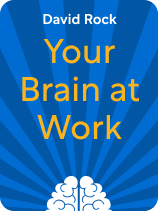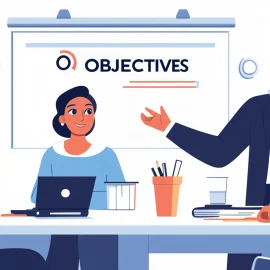

This article is an excerpt from the Shortform book guide to "Your Brain at Work" by David Rock. Shortform has the world's best summaries and analyses of books you should be reading.
Like this article? Sign up for a free trial here.
How can you be better prepared to go into a stressful situation? Once you’re in one, what should you do?
Your emotions impact your energy and your energy impacts your productivity. When you understand how your brain’s limbic system works, you can improve how you regulate your emotions and enjoy more energy and productivity as a result.
Continue reading to learn about managing emotions in the workplace, including some practical advice on what to do before and during emotional situations at work.
Managing Emotions in the Workplace
In order to accurately manage your productivity, be aware of how the emotional part of your brain influences your mental energy. Rock explains that, while cognitive tasks occur in the front of the brain, emotions are processed in the central regions, collectively called the limbic system. We’ll first discuss how the limbic system can both enhance and impede your productivity, and then we’ll cover ways to manage emotions in the workplace so they don’t disrupt your energy levels.
The Science
Rock classifies the signals we receive from our limbic system as toward and away emotions because they pull us emotionally either toward something or away from it.
(Shortform note: Rock credits scientists Evian Gordon and Leanne Williams with developing the emotional spectrum of toward to away, defining an emotion as an automatic response to a stimulus; the response either puts your brain in a toward state, in which it’s receptive and eager for more information, or an away state when your brain can’t process information well. Gordon’s and Williams’s theory has been widely adapted in the fields of psychology and education.)
Toward emotions are positive feelings such as curiosity and happiness. When we experience toward emotions, our limbic system emits dopamine, serotonin, or oxytocin, all of which can give us a boost of energy we can use to complete a task (and make us want to move toward the task).
Away emotions are negative feelings like anxiety, fear, and sadness. Our cortisol and adrenaline levels heighten when we feel away emotions, and our brain wants to avoid the task (move away from it). Since avoidance is not an option in most cases, we expend even more energy forcing ourselves to work on the task. Consequently, the prefrontal cortex has less energy to do the task well.
For example, if you start a project that is new but compelling, you might be curious to try it. Your dopamine levels will rise, and your prefrontal cortex will reenergize to engage in the task. However, if the project is different from anything you’ve done before and requires skills you’re not good at, you may feel anxiety instead and have less energy to motivate yourself to get started.
(Shortform note: Though Rock’s focus is on creating toward emotions and reducing away emotions, away emotions are not always a bad thing. In the book Emotional Intelligence, psychologist Daniel Goleman explains that negative emotions are especially critical for survival as they allow us to assess a situation quickly. For instance, if you hear shouting, fear may alert you to potential danger even before you can register what is being said or who is shouting. Away emotions become a problem when they aren’t suited to the environment. For example, you know your boss has a loud voice and dramatic personality, but your emotions keep responding as if he’s shouting or angry at you.)
How to Use the Science
Rock illustrates that mindfulness—self-awareness—is the first step to harnessing your emotions for productivity. You have to be able to identify when you’re feeling away or toward emotions and then anticipate situations likely to trigger these emotions. After recognizing your emotional response, you can decide whether to use toward emotions to motivate you on a task or prevent away emotions from disrupting your task. Rock explains that we feel our away emotions more intensely, so the strategies he recommends mostly involve regulating our brains when threatened.
| Techniques to Practice Mindfulness Practicing mindfulness can help you recognize your away and toward emotions because it helps you build awareness of your brain and body, giving you a greater command of how they react to external stimuli. Here are some tips from mindfulness experts: • Start and end each day with breathing exercises. For a few minutes, take deep and slow breaths. Still your thoughts about work or other things going on and focus on the sensation of your breath and movement of your body. • Incorporate breathing breaks into your day. Designate a part of your routine as a trigger for a breathing exercise. For example, you can decide that each time you hang up a phone call or close a door, you’ll take five deep breaths to recenter yourself. • Eat meals in a separate location from where you work. Meals are an opportunity for your body to recharge. Don’t distract your refueling process while trying to work simultaneously. |
Before an Emotional Situation
Rock claims that you can minimize away emotions in stressful situations by preparing beforehand. He recommends the following techniques:
Carefully select which situations you participate in. If you know that a situation is going to be stressful enough to hinder you from doing your best, you can find ways to remove yourself from it. For example, if public speaking gives you anxiety, and you have an upcoming presentation, you could delegate the task to a team member or ask to complete parts of the project that don’t involve presenting.
Adjust your situation. You can decrease your away emotions by changing something about the event to make it more comfortable for you. For example, you realize you have multiple projects due on the same day. You know you’re going to feel overwhelmed once the deadlines approach, so you delegate some tasks to your team or ask for an extension on one of the projects.
(Shortform note: You don’t always have a say in what you’re assigned at work, so if you know that certain situations like public speaking or networking events trigger away emotions, experts suggest that you try to get exposure to your fears in a controlled setting. Programs like Toastmasters hold training sessions in common leadership skills and can help you build confidence.)
Deny away emotions your attention. Before a difficult situation, you can decide to not pay attention to away emotions. Rock clarifies that this choice is hard to do and requires practice in recognizing and deferring emotions from entering your prefrontal cortex. This method is also energy-intensive, and it may affect your productivity for the rest of the day.
| Find Time To Address Away Emotions If you successfully put your emotions on hold to accomplish a task, experts encourage you to take time later to process your away emotions. Reflecting on your away emotions can have several benefits: • If a situation constantly makes you feel discomfort and anger, your consistent, negative emotions may be a sign that you need to make changes in your life. • Negative feelings can give you a more realistic perspective of a situation, especially if you were previously naive or overconfident before. • Negative emotions help you learn from your mistakes. While away emotions are important, you don’t want to feel them often, so recognizing that a mistake brought you anxiety or stress may help prevent you from making the mistake again. |
During an Emotional Situation
Rock notes that sometimes we’re not in a position to make changes before a situation, or our away emotions catch us by surprise. In these cases, we need to take different approaches during an emotional situation.
Express your emotion: Occasionally, the best way to get an away emotion out of our prefrontal cortex is to express it. For example, if an event brings you grief, allow yourself to fully feel the emotion; crying or other forms of release may be the best way to work through the emotion. Rock notes this is probably not the most productive strategy in the workplace, so you do need to be aware of how appropriate it would be in any given environment.
(Shortform note: If you need to express a powerful emotion, do so in ways that don’t invite unwanted consequences, so that you remain professional. For example, you might find a bathroom stall and allow yourself to feel your emotions in private. Or, write down your emotions to better focus on the situation calmly.)
Suppress your emotion: If you feel your away emotions rising, you can sideline them to bring the task at hand into focus. However, Rock cautions that it’s hard to appear calm or sincere when you have to abruptly suppress your emotions in the moment (as opposed to preparing beforehand). Depending on the situation, you may come off as cold or indifferent, especially if those around you are expecting an emotional response. For example, in a budget meeting, someone reports that a project has gone over the allocated costs. If you suppress a reaction and focus on finishing the meeting, people may interpret your response as not taking the report seriously.
(Shortform note: Some wellness experts assert that men especially have a difficult time both expressing and suppressing emotions. Men are often socialized to avoid emotional vulnerability, habitually suppressing emotions until they have no choice but to express them—often at inopportune times or at inappropriate levels of intensity. While Rock advises that you only suppress your emotions temporarily, it should be noted that male-dominated fields do tend to praise the ability to compartmentalize and remain rational. Continuous emotional suppression can lead to health risks like physical pain or an increased likelihood of substance abuse.)
Reinterpret your emotion: This is the approach that Rock believes works best in a professional setting. You can decrease your away emotions by naming them and then reframing them in an optimistic light.
First, acknowledge and name the emotion, either mentally or aloud. Try to do this in one sentence, like “I’m feeling anxious because I did not expect the boss to attend the presentation.” This simple act allows you to quickly address the emotion and quell the panic from being caught off-guard. When your brain can specifically identify the problem, you can take steps to solve it rather than letting a nebulous discomfort accumulate and take over.
Sometimes, the limbic system is soothed just by recognizing the emotion, but in situations in which the away emotion is too disruptive to stop there, Rock suggests trying to see your away emotions from a positive perspective. For example, you meet a coworker on your first day at a job, and they start to ask a long stream of questions. Your first reaction may be to feel interrogated and defensive. However, by reinterpreting the situation, you could view their questioning as a way to get to know you instead. By shifting your away emotion to a toward emotion, you can continue your day productively rather than letting your mind linger on a potentially negative interaction.
| Identify What’s Within and Outside Your Control One of the tenets of Stoic philosophy, according to Ryan Holiday in The Daily Stoic, is to gain control over your emotions by realizing they are one of the few things that are actually in your control. You can’t control what happens, but you can control how you feel and respond to it. One of the Stoic methods of asserting control over your emotions is modifying your self-talk, or what your mind “says” to you after being triggered by a negative event. For example, if you had an embarrassing experience during a public speaking engagement, giving speeches may trigger your away emotions. While you’re on stage, your brain may be thinking, “I’m in danger. I’m going to humiliate myself again.” Instead, think to yourself with kindness and encouragement: “I’m doing something brave. I’m going to be OK.” |
Exercise: Manage Emotional Situations at Work
Rock provides options for responding to away emotions. Before a stressful situation, you can avoid or modify the situation, or keep emotions out of it. During a stressful situation, you can express, suppress, or reinterpret negative emotions.
- What is an event or task at work that elicits away emotions (stress, anxiety, and so on)?
- How might you prepare for that event or task in the future? Are there adjustments to the situation you can make ahead of time to lessen your stress response?
- If you end up in that stressful situation again, how might you use Rock’s techniques to lessen the negative feelings associated with it? How might you professionally express your emotions? Can you rethink your emotions to put a positive spin on them?

———End of Preview———
Like what you just read? Read the rest of the world's best book summary and analysis of David Rock's "Your Brain at Work" at Shortform.
Here's what you'll find in our full Your Brain at Work summary:
- How leaders can generate productive work environments
- How to schedule your day around your brain's energy levels
- Three steps to reactivate your creativity after a creative block






